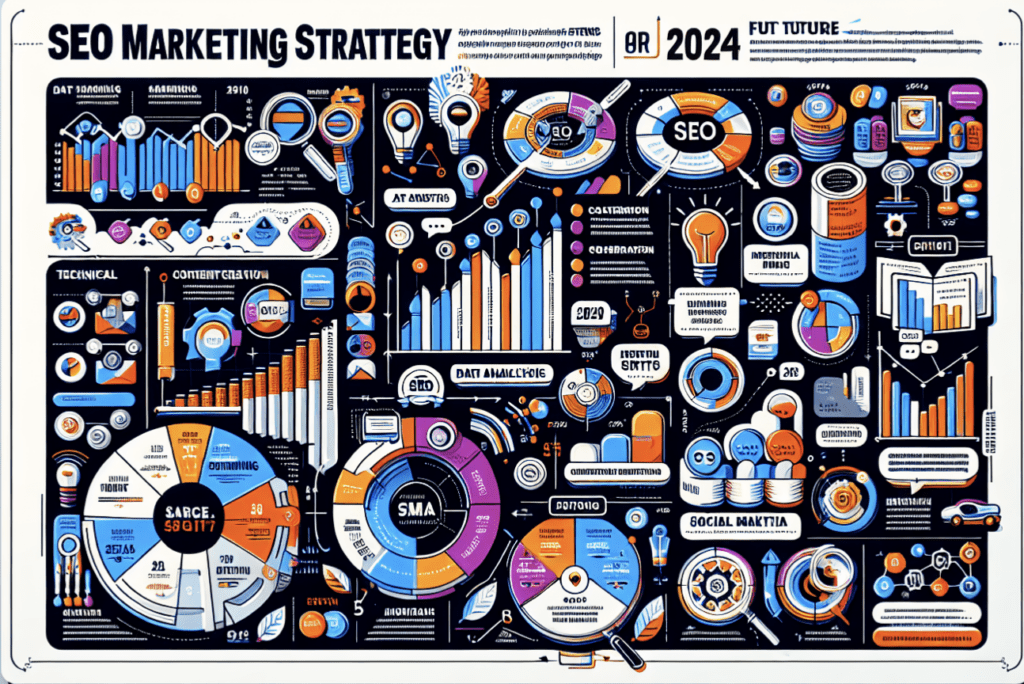SEO Marketing Strategy Trends in 2024: Skills You Need to Learn for Success
SEO Marketing Strategy Trends in 2024: Skills You Need to Learn for Success
As 2024 approaches, your SEO marketing strategy must evolve to meet the latest trends shaped by advancements in technology and shifts in consumer behavior. The landscape of search engine optimization strategy is increasingly influenced by artificial intelligence (AI), particularly with new developments like Google’s Search Generative Experience (SGE).
This highlights the need for your approach to SEO to adapt, prioritizing direct answers to user queries through optimized content and video SEO. Understanding and mastering the intricacies of technical aspects, such as indexing, Google search algorithms, and content creation, are essential for maintaining relevance and achieving success in the digital space.
Staying ahead in search results now requires a nuanced grasp of key elements including user experience, meta descriptions, link building, and keyword research. Your strategy should not only focus on traditional SEO practices such as on-page SEO and backlinks but also embrace emerging trends like voice search optimization and mobile-first indexing. As the criteria for high ranking factors continue to prioritize user satisfaction and content quality, developing a comprehensive content strategy that encompasses core web vitals, local SEO, and technical SEO becomes crucial for standing out in a crowded digital landscape.
The Shift to AI and Machine Learning
Emerging technologies such as AI-driven algorithms, machine learning, augmented reality (AR), and virtual reality (VR) are set to revolutionize how we discover and interact with video content. These advancements are not just enhancing user experiences but are reshaping the SEO landscape by improving how content is indexed and served to users.
AI and Machine Learning in Content Generation and SEO
AI technology is not only about automation but also about enhancing creativity and efficiency. Tools like seoClarity, Surfer, and Letterdrop have introduced AI automation capabilities that streamline various SEO tasks. For instance, AI can now generate and repurpose text content into engaging videos, making content more accessible and appealing to a broader audience.
Integrating AI Tools for Enhanced SEO Performance
Several AI tools are becoming indispensable for SEO specialists. Coefficient, for example, simplifies data analysis by integrating with Google Sheets and GPT models, connecting directly to essential SEO data from Google Search Console. This integration allows for a more streamlined analysis of SEO metrics, enhancing the ability to make informed decisions quickly.
The Role of AI in Content Optimization and User Experience
AI-driven tools like Quillbot and Frase are revolutionizing content creation and optimization. Quillbot focuses on enhancing readability and SEO results by improving the clarity and impact of on-page content. Frase offers automated content briefs and SEO scoring, ensuring articles are optimized for higher rankings. These tools help in maintaining a balance between user engagement and adherence to SEO best practices.

Predictive Analytics and Personalization
AI’s ability to analyze large volumes of data and predict trends is transforming SEO strategies. Tools empowered with machine learning algorithms can now analyze user behavior, search patterns, and even predict future trends, allowing marketers to stay ahead of the curve. This capability leads to more personalized user experiences, as AI can tailor content to meet the unique preferences and behaviors of individual users.
Adapting to AI-Driven SEO
For SEO strategies to remain effective, embracing AI is crucial. As AI continues to play a significant role in SEO, adapting to its advancements is necessary for any business looking to thrive online. Leveraging AI for content creation, site optimization, and quality enhancements will be vital for achieving long-term success in an increasingly competitive digital landscape.
By understanding and integrating these AI-driven tools and strategies, businesses can enhance their SEO efforts, leading to better content visibility, user engagement, and overall website performance. As we move further into 2024, the synergy between AI technologies and SEO practices will undoubtedly become more pronounced, making it essential for marketers to continuously learn and adapt to these changes.
Voice Search Optimization
Voice search optimization is becoming increasingly vital as over 50% of all internet searches are now voice-activated, with expectations for this number to rise. Each month, more than one billion voice searches are conducted, highlighting the growing preference for voice over traditional typing due to its ease of use, especially when on the move, and the accessibility of voice-activated devices.
Understanding Voice Search Platforms
The major players in the voice search arena are Google Assistant, Siri, and Alexa. Each platform has its unique characteristics:
- Google Assistant and Siri: Predominantly pull data from Google, but Siri also accesses other search engines like Yahoo and Bing, as well as Apple’s third-party apps.
- Alexa: As an Amazon product, Alexa primarily retrieves information from Bing.
Given the differences in data sourcing, it’s crucial to optimize for all three platforms to maximize visibility and effectiveness.
Behavioral Differences in Search Queries
Voice searches differ significantly from typed searches in terms of user behavior and the nature of the queries:
- Conversational Queries: Voice search queries tend to be more conversational. For instance, instead of typing “pumpkin pie recipe,” a user might ask, “How do I make pumpkin pie?”
- Intent Recognition: Tools like Google’s RankBrain and the Knowledge Graph are adept at understanding and categorizing the intent behind a query into informational, navigational, actional, and transactional.
Optimization Strategies for Voice Search
To effectively optimize for voice search, consider the following strategies:
- Long-Tail Keywords: Focus on phrases that mimic natural speech to improve match potential with conversational queries.
- Mobile Optimization: Ensure your website is responsive and loads quickly as many voice searches are performed on mobile devices.
- Structured Data: Use schema markup to help search engines understand your content better, enhancing the chances of your information being used to answer voice queries.
- Featured Snippets: Aim to get your content into ‘position zero’ as voice assistants often read out the featured snippets in search results.
- Local SEO: Optimize for local searches as many voice queries include local intent, such as finding nearby services or directions.

Leveraging AI for Voice Search
AI technologies enhance the understanding and processing of natural language used in voice queries. Implementing AI-driven tools can help in:
- Natural Language Processing: Improving the way voice queries are interpreted.
- Content Optimization: Using AI to generate content that is more likely to meet the conversational tone and context of voice searches.
By integrating these AI capabilities, you can significantly boost your SEO strategy for voice search, making your content more accessible and visible through voice-activated devices.
Mobile-First Indexing
Understanding the importance of mobile-first indexing is crucial as it significantly impacts how your website is viewed and ranked by Google. Since the introduction of this approach, Google predominantly uses the mobile version of the content for indexing and ranking, which underscores the necessity for a mobile-friendly website design.
What is Mobile-First Indexing?
Mobile-first indexing means that Google predominantly uses the mobile version of a website’s content for indexing and ranking. Historically, the index primarily used the desktop version of a page’s content, but with the majority of users now accessing the internet via mobile devices, the shift to mobile-first indexing was inevitable.
Why Mobile Responsiveness is Crucial
- Increased Mobile Usage: With more people accessing the internet via mobile devices, your site’s mobile responsiveness directly influences user experience and engagement.
- SEO Impact: Websites optimized for mobile are favored in search rankings, making mobile responsiveness a critical part of SEO strategy.
Optimizing Video Content for Mobile
Given the surge in mobile usage, optimizing video content for mobile search visibility is essential. Videos need to be responsive, ensuring they adjust to different screen sizes and orientations seamlessly. This not only improves user experience but also supports SEO efforts as it enhances engagement and reduces bounce rates.
Key Strategies for Mobile SEO
- Responsive Design: Ensure your website’s design adjusts smoothly to fit different screen sizes and resolutions.
- Speed Optimization: Mobile users expect quick loading times. Optimize images, leverage browser caching, and minimize redirects.
- User Experience: Simplify navigation and keep the interface user-friendly to enhance engagement and reduce bounce rates.
By focusing on these aspects, you can ensure that your website not only complies with Google’s mobile-first indexing but also provides a positive experience for mobile users, thereby improving your overall SEO performance.
The Importance of Video Content
Why Video Content is Essential in SEO
Video content has become a powerhouse in digital marketing, capturing over 80% of all web traffic in 2024. It’s not just about attracting views; video is a critical tool for improving search engine rankings and engaging users more deeply than traditional text-based content.

Key Benefits of Video Content
- Enhanced User Engagement and SEO Rankings
- Videos increase user engagement significantly, with metrics like watch time, clicks to play, and completion rates serving as key indicators of user interest and engagement.
- Engagement metrics such as watch time, likes, shares, comments, and click-through rates are directly linked to improved search rankings.
- Accessibility and Learning Adaptability
- Video content caters to various learning styles, making information more accessible and easier to digest for a broader audience.
- Increased Shareability Across Platforms
- Videos are inherently shareable, easily distributed across different platforms and channels, amplifying reach and impact.
Strategic Optimization of Video Content for SEO
- Keyword Research and Metadata Optimization
- Conducting thorough keyword research and optimizing video titles, descriptions, and tags are fundamental steps to enhance video discoverability.
- Use YouTube keyword research tools to identify and implement target relevant keywords, boosting your video’s visibility in search results.
- Utilizing Video Schema Markup
- Implementing video schema markup is crucial as it helps search engines like Google understand the video content on your site, enhancing the likelihood of appearing in search results.
- Leveraging AI for Video SEO
- AI tools can be employed to optimize content, ensuring it matches the conversational tone and context of user searches, which is especially important for voice search compatibility.
Video Content’s Role in Driving Traffic and Authority
- Securing Featured Snippets and Rich Search Results
- Optimized video content can secure featured snippets and rich results, driving significant traffic and boosting your site’s authority.
- Dominance in Google Search Results
- Video content often takes up more real estate on Google’s first page, highlighting its importance in a comprehensive SEO strategy.
- Impact on Social Media Engagement and Customer Support
- Beyond SEO, video content enhances social media engagement and can be an excellent tool for customer support through how-to guides and tutorials.
The Growing Importance of Video on Various Platforms
- YouTube as a Major Player
- With YouTube being the second largest search engine, creating impactful video content is crucial for making a significant online impact.
- The Video Creator Pack
- Tools like the Video Creator Pack simplify the video production process, ensuring content not only looks professional but also resonates well with the target audience.
By integrating these strategies into your SEO plan, you harness the full potential of video content to not only enhance user engagement but also drive meaningful traffic and improve your overall digital marketing efforts.
User Experience (UX) and SEO
User experience (UX) plays a pivotal role in shaping the effectiveness of your SEO strategies. It’s crucial to understand that UX directly impacts user satisfaction, retention, and conversion rates, making it a key player in the digital landscape of 2024.
The Symbiotic Relationship Between UX and SEO
UX and SEO share a symbiotic relationship where improvements in one area can significantly boost the other. A well-designed user interface ensures that your website not only attracts visitors but also keeps them engaged. This is because search engines like Google use user signals such as time spent on site, bounce rates, and user engagement as metrics to rank websites. By focusing on delivering a superior user experience, you inherently enhance your SEO efforts.
Enhancing Site Speed for Better UX and SEO
One of the most critical aspects of UX that affects SEO is site speed. Users expect fast-loading pages, and search engines reward websites that provide them. By optimizing your website’s loading speed, you not only improve user experience but also boost your SEO rankings. Here are some strategies to enhance your site speed:
- Minimize HTTP requests by reducing the number of elements on your page.
- Compress and optimize file sizes for images, CSS, and JavaScript.
- Utilize browser caching to store resource files on a local computer when a user visits your site.
- Implement a content delivery network (CDN) to distribute the load of delivering content.
Key UX Design Factors for SEO Success
To further intertwine UX with SEO, focus on several design elements that can enhance your website’s visibility and user engagement:
- Mobile Responsiveness: Ensure your site is fully responsive and provides a seamless experience across all devices and screen sizes. This is crucial not only for user satisfaction but also for improving your rankings in mobile-first indexing.
- Intuitive Navigation: Create a clear, logical navigation structure with easily recognizable links and a well-organized menu. This helps users find information quickly and reduces bounce rates, positively impacting your SEO.
- Accessible Content: Use semantic HTML to structure your content clearly and alt text to describe images, aiding in both accessibility and search engine indexing.
- Contrast and Legibility: Ensure that your text is easy to read with sufficient contrast against the background, which enhances user engagement and interaction.

Leveraging AI for Personalized User Experiences
AI technology has become a cornerstone in delivering personalized user experiences. By analyzing user data, AI can tailor content and recommendations to individual preferences, thereby increasing engagement and satisfaction. This personalization not only boosts user experience but also improves SEO as search engines value highly engaging, user-focused content.
Continuous Improvement Through User Feedback
Regularly collecting and analyzing user feedback is essential for continuous UX improvement. Implement tools to gather user input and track behavior on your site. This data is invaluable for making iterative enhancements that respond to user needs, further solidifying the foundation of your SEO strategy.
By prioritizing UX in your SEO efforts, you not only foster better user engagement and satisfaction but also set the stage for higher organic search rankings and increased visibility. This strategic focus on UX is essential for businesses aiming to succeed in the competitive digital landscape of 2024.
Local SEO and Global Reach
Local SEO is pivotal for businesses aiming to enhance their visibility to nearby customers. With over 50% of Google searches being local and 90% of these searches used to explore local businesses, the significance of local SEO cannot be overstated. It not only helps businesses appear in searches when potential customers look for relevant products or services but also drives more qualified leads, boosts website traffic, and increases conversions.
Key Components of Local SEO
- Google Business Profile Optimization: This is crucial for local SEO as it significantly influences rankings. Ensure your profile is complete with up-to-date information, photos, and reviews.
- NAP Citations: Consistency in your Name, Address, and Phone number across all platforms helps search engines trust your business, improving visibility.
- Local Keywords: Utilize keywords that connect your business to your community, making it easier for local customers to find you when they need your products or services.
Enhancing Local SEO Through Community Engagement
Engaging with local online communities and building positive online reviews are effective strategies for boosting local SEO. These activities not only increase your visibility but also build trust and credibility within your local area. Partnering with other local businesses and sponsoring events can further strengthen your local presence.
Advanced Local SEO Strategies
- Embedding a Google Map on Your About Page: This helps in reinforcing your location-based relevance to search engines and users.
- Location-Focused Keywords: Use these in strategic positions on your website to improve visibility in local search results.
- Optimizing Meta Descriptions: Tailor these for local searchers to improve click-through rates from search engine results pages.
Local SEO ties your business to the specific location it serves, acting as a modern digital billboard on the busiest streets of your neighborhood. This targeted approach not only gives you a competitive edge but also serves as a crucial tool for mobile searches, where immediacy and proximity are key drivers of search behavior.
By implementing these strategies, businesses can effectively increase their visibility in online searches specific to their location, making them the go-to option for local customers. This targeted visibility is essential, especially in a digital age where local and mobile searches are predominant.

Advanced Analytics for SEO
Advanced analytics tools are indispensable in the ever-evolving field of SEO, especially as we move into 2024. These tools not only provide deep insights into website performance but also help in fine-tuning strategies to enhance search engine rankings effectively. Here’s a breakdown of the types of tools available and their integration capabilities, which can significantly streamline your SEO efforts.
Types of SEO Tools and Their Integration Capabilities
- SEO Audit Tools: Tools like SEOptimer and SEOquake offer real-time SEO metrics and comprehensive on-page SEO audits. These are essential for identifying issues that could be hindering your site’s performance.
- Keyword Research Tools: Platforms such as Ahrefs and SEMrush are renowned for their robust keyword research capabilities. They help you discover competitive keywords and track your rankings effectively.
- Rank Trackers: Tools like Serpstat provide budget-friendly rank tracking solutions, which are crucial for monitoring your website’s position in search engine result pages.
- All-in-One Tools: seoClarity and Surfer encompass a broad spectrum of SEO functionalities from audits to competitor analysis, making them versatile choices for comprehensive SEO management.
Integration with Other Apps
SEO tools today offer integration capabilities with popular productivity and management apps. This enhances workflow efficiency and allows for a more cohesive data management approach. For example:
- Slack and Discord: These integrations facilitate real-time alerts and updates on SEO metrics directly within team communication channels.
- Google Tasks and Airtable: These apps help in task management and organizing SEO campaigns, ensuring that all team members are on the same page.
- Google Analytics: Integrating SEO tools with Google Analytics allows for a deeper analysis of website traffic and user behavior, providing insights that are critical for refining SEO strategies.
Advanced Features of Top Web Analytics Tools
The landscape of web analytics tools is rich with options that offer varied functionalities to suit different SEO needs. Here are some of the top tools available in 2024:
- Google Analytics: Remains the go-to free tool for comprehensive traffic and user behavior analysis.
- SimilarWeb and Clicky: Provide insights into your website’s performance compared to competitors.
- Hotjar and Crazyegg: Offer behavior analytics, including heatmaps and user interaction recordings, which are invaluable for understanding user engagement.
Leveraging AI and Predictive Analytics in SEO
AI and predictive analytics are transforming SEO by enabling more accurate forecasts and real-time data analysis. Here’s how they are being integrated into SEO strategies:
- Predictive AI: Tools powered by AI can predict changes in search algorithms and user behavior, helping you stay ahead of SEO trends.
- Real-Time Data Analysis: AI’s ability to process vast amounts of data instantly means you can quickly adapt your strategies based on current search trends and content performance.
Key Resources for Enhancing Your SEO Knowledge
To stay updated and refine your SEO skills, consider exploring these resources:
- SEO Guides and Checklists: Titles like “Learn SEO,” “The Complete SEO Checklist,” and “Technical SEO” offer foundational and advanced knowledge.
- Content Marketing Resources: Guides such as “Content Writing 101” and “Blog SEO” are crucial for anyone looking to enhance their content for better SEO performance.
By utilizing these advanced analytics tools and resources, you can ensure that your SEO strategies are not only effective but also ahead of the curve, tailored to meet the demands of the digital landscape in 2024 and beyond.
Conclusion
As the digital marketing landscape continues to evolve with emerging technologies and changing consumer behaviors, understanding and adapting to the latest SEO marketing strategy trends is crucial for success in 2024. The integration of AI and machine learning, the importance of voice search optimization, the necessity of mobile-first indexing, the power of video content, the significance of user experience, local SEO’s impact on global reach, and the advancement of analytics tools highlight the multifaceted approach needed to stay ahead in the SEO game.
Embracing these elements within your marketing strategy is essential for enhancing online visibility, user engagement, and ultimately, business performance in the competitive digital marketplace.
The journey through 2024’s SEO landscape emphasizes the importance of continuous learning and adaptation to leverage AI-driven tools, voice optimization, video content, and impeccable user experiences for improved search rankings and user satisfaction.
Businesses must focus on integrating these trends into their SEO strategies to thrive online. As we move forward, the symbiosis of technology and SEO offers a wealth of opportunities for those willing to innovate and adapt, ensuring relevance and supremacy in the ever-changing digital domain.


